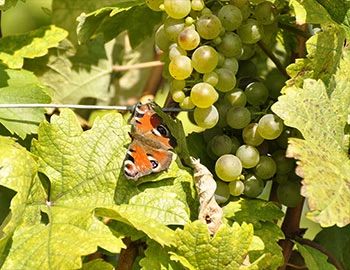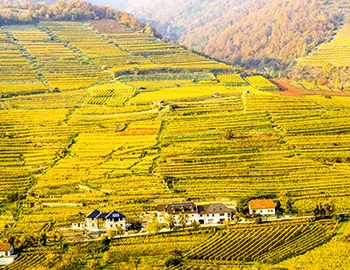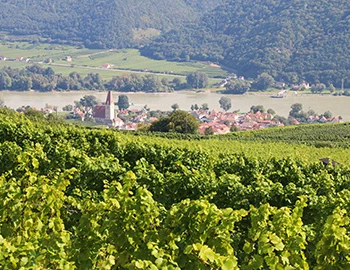Ried Grub 1. Lage Grüner Veltliner 2022
DAC Kamptal Reserve, Schloss Gobelsburg, 750 ml

| Grape variety: | Grüner Veltliner |
| Producer: | Weingut Schloss Gobelsburg |
| Origin: | Austria / Niederösterreich / Kamptal |
Description
The protected vat (Grub, Grube = pit) produces a powerful wine with an intense and complex aroma of blood orange, exotic fruit such as mango and pineapple and a hint of caramel, saffron and nutmeg. Full and opulent on the palate, supported by a perfectly integrated acidity. Its pronounced taste and the characterful mineral astringency resonate for a long time with a hint of forest honey.
Attributes
| Origin: | Austria / Niederösterreich / Kamptal |
| Grape variety: | Grüner Veltliner |
| Label: | Vegan |
| Ripening potential: | 2 to 10 years |
| Drinking temperature: | 10 to 12 °C |
| Food Pairing: | Mild Asian dishes, Baked egli fillets with tartare sauce, Crispy roast chicken, Cheese board, Risotto with ceps |
| Vinification: | soft pressing, fermentation in steel tank |
| Harvest: | hand-picking, strict selection, in small boxes |
| Maturation: | in large wooden barrel/foudre |
| Bottling: | filtration |
| Volume: | 13.5 % |
| Note: | Contains sulphites |
Grüner Veltliner
From Austria to the world
With the Grüner Veltliner, the Austrians have conquered the world. In New York bars today, people order "a glass of Gruner" as nonchalantly as if they have never drunk anything else. Despite its name, it has nothing to do with the northern Italian region of Valtellina (Veltlin in German). It is a natural cross between Traminer and a grape Methuselah with a unique DNA profile, found in Sankt Georgen in the Leitha Mountains. As far as is known, this is the only stock of its kind. Grüner Veltliner demonstrates exceptional versatility. It yields fresh, lively whites with the typical “pfefferl” – a spicy, piquant note – as well as dense, mineral top wines. Sparkling and sweet wines are also pressed from them. In total, it occupies almost two-thirds of Austrian vineyards. It achieves its best along the Danube, around the Kamp Valley, in Kremstal or in the Wachau.

Kamptal
Kamptal: a dynamic atmosphere north of the Danube
With an ever-growing number of leading vintners, Kamptal has increasingly stood out in recent years from the shadow of the legendary Wachau region. The basis for this are the various terroirs in this broad-ranging valley. At Loisium, the region is also host to a spectacular, futuristic visitor center.

Niederösterreich
Lower Austria: crus near and far from the Danube
Austria's largest state is also its largest wine region. 46,000 hectares are planted with vines in Lower Austria. It is a heterogenic wine region, consisting of eight wine growing areas. While white varieties like Grüner Veltliner and Riesling dominate in the areas north and west of Vienna, red varieties set the tone in the south and in the southeast (Thermenregion and Carnuntum). The internationally famous white crus from Grüner Veltliner and Riesling develop in the picturesque Wachau and Kamptal.

Austria
Austria – Sumptuous culture, accessible to all
Austria is characterized by unbelievable topographical diversity. A flat steppe in the east, forests and hills in the Alpine regions, wetlands and Mediterranean landscapes in the south. This in addition to a rich tradition and even greater love. It’s no surprise that the Romans found joy on this patch of Earth and cultivated wine growing. Austrian wine is not abundant, but it is high quality.



